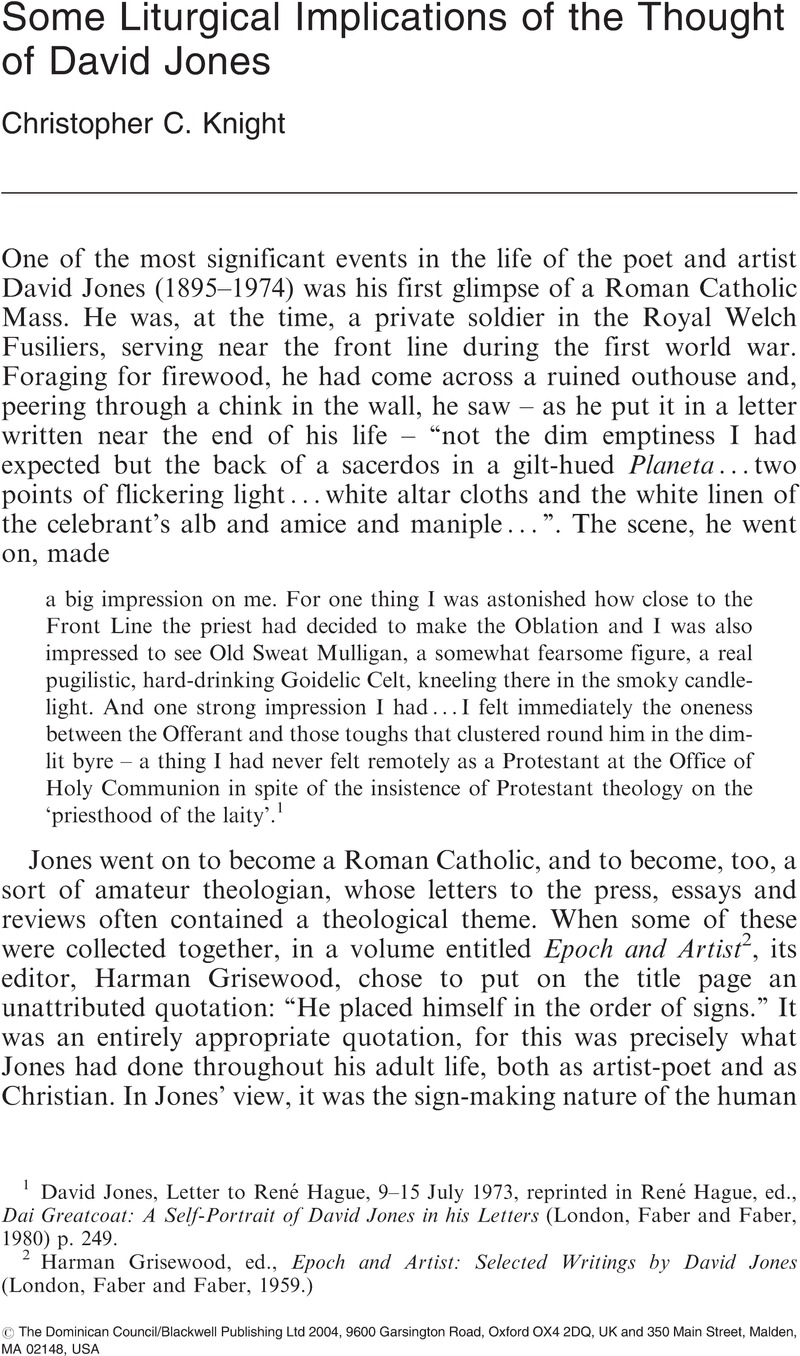No CrossRef data available.
Published online by Cambridge University Press: 01 January 2024

1 David Jones, Letter to René Hague, 9–15 July 1973, reprinted in Hague, René, ed., Dai Greatcoat: A Self-Portrait of David Jones in his Letters(London, Faber and Faber, 1980) p. 249Google Scholar.
2 Grisewood, Harman, ed., Epoch and Artist: Selected Writings by David Jones(London, Faber and Faber, 1959.)Google Scholar
3 Maurice de la Taille, The Mystery of Faith and Human Opinion Contrasted and Defined, tr.Schimpf, J.B. (London, Sheed and Ward, 1930) p. 212Google Scholar.
4 Jones, “Art and Sacrament” in Epoch and Artist p. 163, footnote.
5 Ibid.p. 163.
6 Ibid. p. 165.
7 Ibid. p. 171.
8 Ibid. pp. 171–2.
9 Ibid. p. 173.
10 Ibid. p. 174.
11 Ibid.
12 Ibid. pp. 175–176.
13 Ibid. p. 176.
14 Ibid. p. 177.
15 Allchin, A.M., “A Discovery of David Jones” in The World is a Wedding: Explorations in Christian Spirituality(London: Darton, Longman and Todd, 1978) p. 162Google Scholar.
16 See especially the Preface to Jones, David, The Anathemata(London, Faber, 1952)Google Scholar. As he noted there (p. 13), “’Tsar’ will mean one thing and ‘Caesar’ another to the end of time.”
17 See, for example, his letter to The Tablet published on 26th April 1958 and reprinted in Epoch and Artist pp. 260–261, in which he discusses the hymn Vexilla Regis.
18 Dai Greatcoat p. 249.
19 David Jones, Letter to Harman Grisewood of 6 July 1964, reprinted in Dai Greatcoat p. 207.
20 David Jones, Letter to René Hague of 8–16 June 1966, reprinted in Dai Greatcoat p. 224.
21 Ibid.
22 Jungmann, J.A., The Place of Christ in Liturgical Prayer, tr. Peeler, A. (London, Geoffrey Chapman, 1965)Google Scholar.
23 F.Torrance, Thomas, “The Mind of Christ in Worship: The Problem of Apollinarianism in the Liturgy”, ch.4 of Theology in Reconciliation: Essays towards Evangelical Unity in East and West(London, Geoffrey Chapman, 1975)Google Scholar.
24 The classical liturgical action is, arguably, not entirely obscured with the new orientation when, either architecturally or in the bodily actions of the celebrant (or preferably both,) there is a strong vertical dimension to the symbolism of the eucharistic action. In practice, however, it is too often the horizontal priest-people (Christ-church) interaction that is emphasized in orientational symbolism rather than any offering to the Father.
25 The Constitution on the Sacred Liturgy, article 59.
26 R.Francis, Mark, “Sacramental Theology”, in McGrath, Alister E., ed., The Blackwell Encyclopedia of Modern Christian Thought(Oxford, Blackwell, 1993) p. 586Google Scholar.
27 Ibid.
28 The best brief introduction to this sociological perspective is perhaps Berger, P.L., Berger, B. and Kellner, H., The Homeless Mind: Modernization and Consciousness(Harmondsworth, Penguin, 1974)Google Scholar
29 Lindbeck, G., The Nature of Doctrine: Religion and Theology in a Postliberal Age(Philadelphia, Westminster, 1984)Google Scholar. For many, the main problem with Lindbeck's analysis is its essentially instrumentalist understanding of religious language. That this is not a necessary inference from his prime insights is, however, argued in C.Knight, Christopher, Wrestling With the Divine: Religion, Science, and Revelation(Minneapolis, Fortress, 2001)Google Scholar
30 Letter to René Hague of 8–16 June, 1966, reprinted in Dai Greatcoat p. 222.
31 Miles, Jonathan and Shiel, Derek, David Jones: The Maker Unmade(Bridgend, Seren, 1995) p. 241Google Scholar.
32 David Jones, Letter to René Hague of 8–16 June 1966, reprinted in Dai Greatcoat p. 224.
33 Miles and Shiel, David Jones p. 7.
34 Ibid.
35 Ibid. p. 293.
36 Dillistone, F. W. (ed.), Myth and Symbol(London, 1966)Google Scholar still remains possibly the best introduction to this issue. See especially the essay in it by Ian T.Ramsey.